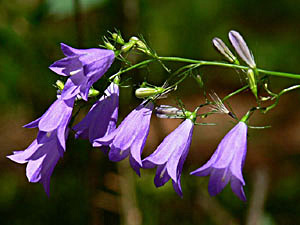
medicinal herbs
Harebell
Campanula rotundifolia

Herb: Harebell
Latin name: Campanula rotundifolia
Family: Campanulaceae (Bellflower Family)
Medicinal use of Harebell:
The root has been chewed in the treatment of heart and lung problems. An infusion of the roots has been used as ear drops for a sore ear. A decoction of the plant has been drunk or used as a wash in the treatment of sore eyes.Description of the plant:

Plant:
Perennial
Height:
40 cm(1 foot)

Flowering:
July toSeptember
Habitat of the herb:
Dry grassy places and on fixed dunes, often in poor shallow soils throughout most of Britain.Edible parts of Harebell:
Leaves - raw or cooked.Propagation of the herb:
Seed - surface sow in spring in a cold frame. Three or four weeks pre-chilling of the seed improves the germination rate. The seed usually germinates in 2 - 4 weeks at 18°C. When they are large enough to handle, prick the seedlings out into individual pots and grow them on in a cold frame for at least their first winter. Plant them out into their permanent positions in late spring or early summer, after the last expected frosts. The seed can also be sown outdoors in situ during the spring. Basal cuttings in spring. Harvest the shoots when they are about 10 - 15cm long with plenty of underground stem. Pot them up into individual pots and keep them in light shade in a cold frame or greenhouse until they are rooting well. Plant them out in the summer. Division in spring or autumn. Very easy, larger clumps can be replanted direct into their permanent positions, though it is best to pot up smaller clumps and grow them on in a cold frame until they are rooting well. Plant them out in the summer or following spring.Cultivation of Harebell:
Dry grassy places and on fixed dunes, often in poor shallow soils throughout most of Britain.Known hazards of Campanula rotundifolia:
None knownPlant information taken from the Plants For A Future.
